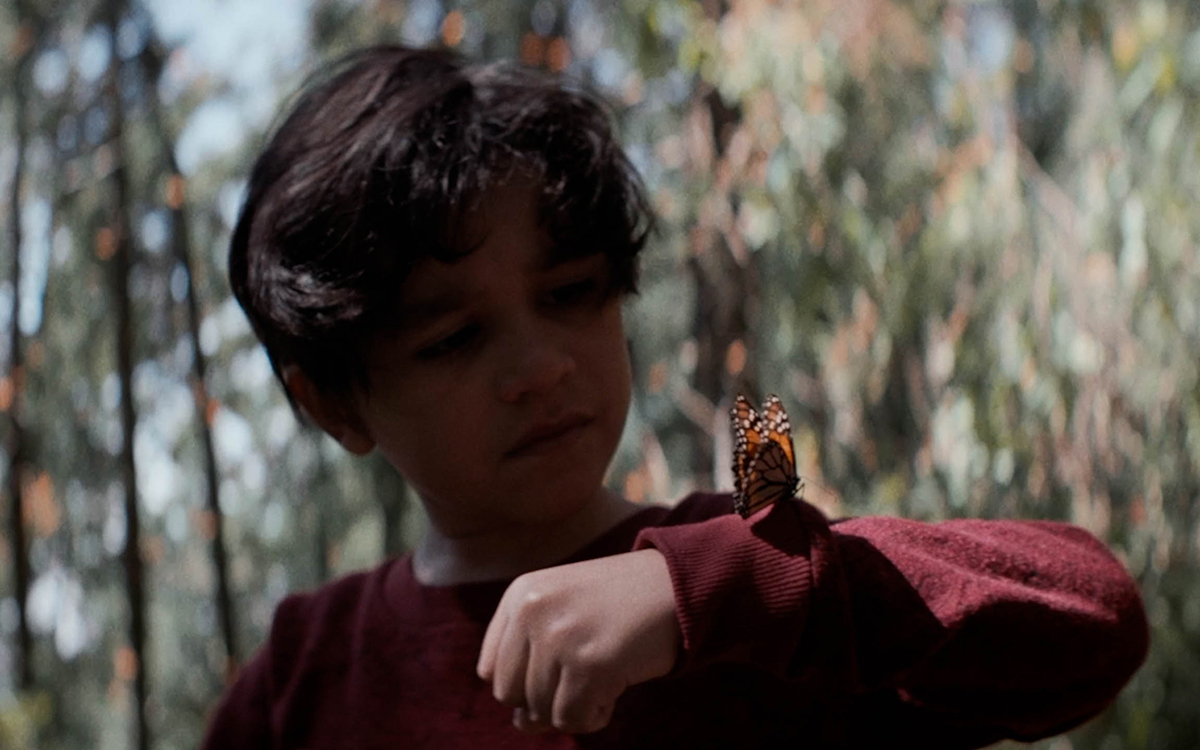“Son of Monarchs” Pays Homage to the Beauty of Migration
A surreal film explores the psyche of an immigrant biologist

Tenoch Huerta plays Mendel, a Mexican scientist studying the mysteries of butterfly pigment. | Photo courtesy of Sundance Institute/Alexis Gambis
To some, a film about a Mexican scientist’s spiritual transformation into a butterfly may seem strange. But to Alexis Gambis, it’s personal. Born to a painter and a filmmaker, Gambis rebelled against a career in art. But after completing a PhD in molecular biology and genetics, he sought ways to bridge his academic research with visual storytelling. “I was really drawn to biology from an aesthetic and narrative point of view,” Gambis told Sierra.
The result is Son of Monarchs, written and directed by Gambis. It is the recipient of the Alfred P. Sloan Prize, awarded to a feature film focused on science and technology, and recently premiered at the 2021 Sundance Film Festival.
The film follows Mendel (played by Tenoch Huerta), an evolutionary biologist who leaves Mexico for New York to study how the genetic engineering tool CRISPR can alter the physical characteristics of butterflies. After discovering that his grandmother has passed away, Mendel travels to Mexico to attend her funeral in Michoacán, home to the Monarch Butterfly Biosphere Reserve. What’s meant to be a two-day visit reconnects him with old friends and family as well as the trauma that drove him away from the place he once called home.
Much of the film unfolds through flashbacks, blurring the lines between Mendel’s childhood in Michoacán and his life in New York. Son of Monarchs explores Mendel’s psychic transformation as he reconciles the loss of his parents, the loss of his culture, and ultimately, the loss of himself.

Mendel as a child, played by Kaarlo Isaacs. | Photo courtesy of Sundance Institute/Alexis Gambis
Although Son of Monarchs explores a range of ideas, Gambis weaves them together with subtle precision. The film is layered with sharp observations on science, spirituality, the environment, and migration. The butterfly migrations of Mendel’s childhood are diminished by deforestation and mining, even as local schoolchildren memorize and reenact the passage of the monarchs from North America to Mexico and perform climate change through folklore dance (the children’s reenactment is based on a real performance that Gambis saw while in Mexico). “As the director, I don't want to take a stance and say, ‘Stop destroying the butterfly forest!’" Gambis said. “I don't want to preach, because I feel that these conversations are so complicated.”
In the film, science and spirituality are not juxtaposed but in conversation with one another. When Mendel embraces his animal spirit during an ancestral ceremony or gazes into his microscope to extract butterfly pigment, the goal of understanding the world is the same.
The film conveys the mundanity of lab work without downplaying its wonder. “Oftentimes, scientific pursuit and research are separated from the spiritual aspect,” Gambis said. “But I feel like they're very much connected. The idea of being in a laboratory and trying to understand the building blocks of life and how things work is the utmost kind of spiritual process.”
Son of Monarchs avoids the dramatization of planetary disruption that’s common in the science fiction genre (think Snowpiercer, Annihilation, and The Martian). “There's this obsession with sensationalizing science where it brings you into these dystopian worlds,” Gambis said. “I love those films, but I feel like there needs to be room for other types of film where the science is the backdrop.... I don't want the character to suddenly say, ‘Oh, I made a discovery!’ I would rather watch him work in the lab in silence. It's part of who he is. He doesn't need to speak about it.”
Just as science is innate to Mendel, so is his hybrid identity as a Latino immigrant living in between cultures. The film expands the definition of what it means to be an immigrant by deviating from reductive tropes of Latin American migration, like the sacrificial immigrant who risks it all for a better life. “What you see in films about Latinos and Mexicans is very stereotypical,” Gambis said. "It's usually about crossing the border. And here, it's about Mexican scientists who actually return to Mexico and live between worlds."

Mendel talks butterflies with his girlfriend (played by Alexia Rasmussen) in New York City. | Photo courtesy of Sundance Institute/Alexis Gambis
“If you go to a research lab today, it's full of people from around the world that come and migrate for work reasons,” Gambis said. “It's a different type of migration that happens in the US.” Mendel’s story is an intimate look into the emotional consequences that follow a sovereign choice, and it’s his negotiation between identity and belonging that makes this film so visceral.
Gambis hopes that viewers walk away from Son of Monarchs with a deeper appreciation of how we are all animals, not only within a specific ecosystem but also as creatures who are as dependent on migration as other species. As a Brooklyn-based immigrant who wrestles with the paradox of cultural belonging—torn between his French, Venezuelan, and American identities—he encourages the audience to think critically about who they are and where they come from.
“I hope people understand that migration is fluid,” Gambis said. “You can leave and come back…. Maybe we don't know where Mendel ends up, but he floats like a butterfly. He's in Mexico, he’s in New York—there's no permanence. It's all cyclical. Of course, it's a certain type of migration, because there are some [migrants] that can't go back home. But I want to emphasize that in the animal world, migration is cyclical, and I hope people can relate to that, and to embrace that migration is beautiful.”
 The Magazine of The Sierra Club
The Magazine of The Sierra Club



